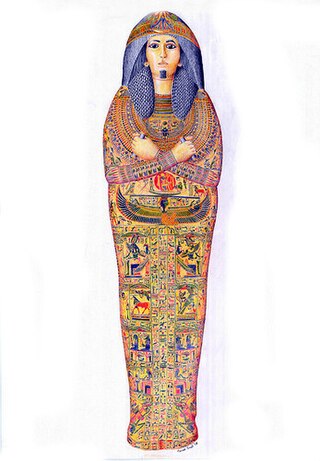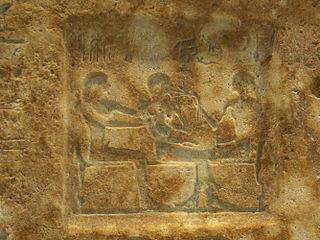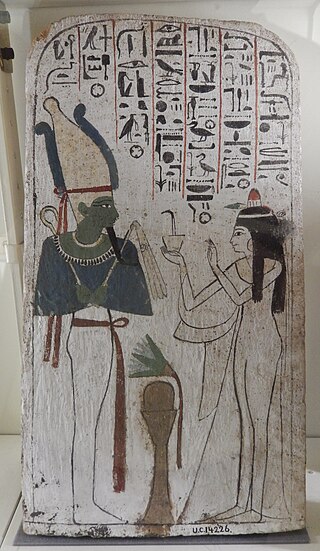
A mummy is a dead human or an animal whose soft tissues and organs have been preserved by either intentional or accidental exposure to chemicals, extreme cold, very low humidity, or lack of air, so that the recovered body does not decay further if kept in cool and dry conditions. Some authorities restrict the use of the term to bodies deliberately embalmed with chemicals, but the use of the word to cover accidentally desiccated bodies goes back to at least the early 17th century.

The ancient Egyptians had an elaborate set of funerary practices that they believed were necessary to ensure their immortality after death. These rituals included mummifying the body, casting magic spells, and burials with specific grave goods thought to be needed in the afterlife.

Tomb KV60 is an ancient Egyptian tomb in the Valley of the Kings, Egypt. It was discovered by Howard Carter in 1903, and re-excavated by Donald P. Ryan in 1989. It is one of the more perplexing tombs of the Theban Necropolis, due to the uncertainty over the identity of one female mummy found there (KV60A). She is identified by some, such as Egyptologist Elizabeth Thomas, to be that of the Eighteenth Dynasty pharaoh Hatshepsut; this identification is advocated for by Zahi Hawass.

The tomb of Yuya and Thuya, also known by its tomb number KV46, is the burial place of the ancient Egyptian noble Yuya and his wife Thuya, in the Valley of the Kings. They were the parents of Queen Tiye, the chief wife of Pharaoh Amenhotep III. Their tomb was discovered in February 1905 by the Egyptologist James E. Quibell, excavating under the sponsorship of American millionaire Theodore M. Davis. The tomb was robbed in antiquity but preserved a great deal of its original contents including chests, beds, chairs, a chariot, and numerous storage jars. Additionally, the riffled but undamaged mummies of Yuya and Thuya were found within their disturbed coffin sets. Prior to the discovery of the tomb of Tutankhamun, this was considered to be one of the greatest discoveries in Egyptology.

Thuya was an Egyptian noblewoman and the mother of queen Tiye, and the wife of Yuya. She is the grandmother of Akhenaten, and great grandmother of Tutankhamun.

KV31 is an ancient Egyptian tomb located in the Valley of the Kings, near Luxor, Egypt. Only the top of the shaft was known prior to excavation by the University of Basel Kings' Valley Project in 2010, and no earlier excavations are known, although it is suggested that the stone sarcophagus excavated by Giovanni Battista Belzoni in 1817 may have originated from this tomb. The tomb was found to be filled with mixed debris of pottery sherds and linen fragments, as well as the remains of five mummified elite individuals dating to the Eighteenth Dynasty.

Nesyamun, also known as Natsef-Amun or The Leeds Mummy, was an Ancient Egyptian priest who lived during the Twentieth Dynasty c. 1100 BC. He was a senior member of the temple administration in the Karnak temple complex and held various titles including "god's father of Montu" and "scribe of Montu", and was responsible for presenting the daily food offerings to the gods and tallying the cattle of the Karnak temple estates. Nothing is known about his family.
This is a glossary of ancient Egypt artifacts.
Dr. Nicholas Byram Millet was an Egyptologist affiliated with the Royal Ontario Museum and the University of Toronto. An archaeologist, art historian, linguist, museum curator, administrator, and celebrated teacher, Millet was able to make great strides in the daunting task of translating the lost language of the ancient Sudan, Meroitic. His careful study of the unusual script led to the decipherment of a number of Meroitic words, phrases, and verb formations, and helped shed some light on the social and political constructs of this mysterious civilization. No one else has approached his level of contribution to knowledge of this important ancient African empire. Millet's final word on the Meroitic language was published posthumously in "The Meroitic Inscriptions from Gebel Adda", The Journal of the Society for the Study of Egyptian Antiquities in 2005.

Ramose was the father and Hatnofer the mother of Senenmut, one of the most important state officials under the reign of the Egyptian queen Hatshepsut in the Eighteenth Dynasty of Egypt. The commoner origins of Ramose and the rise of his son Senenmut were long considered to be prime examples of high social mobility in New Kingdom Egypt. For instance, almost nothing is known of Ramose's origins, but he seems to have been a man of modest means—anything from a tenant peasant or farmer, to an artisan or even a small landowner. When Ramose died he was a man aged 50–60. Hatnofer was an elderly lady, with grey or even white hair. They are believed to have been born at Armant, a town only ten miles (16 km) south of Thebes within Upper Egypt presumably during the reign of Ahmose I, the founder of Egypt's illustrious 18th dynasty.

Animal mummification was common in ancient Egypt. Animals were an important part of Egyptian culture, not only in their role as food and pets, but also for religious reasons. Many different types of animals were mummified, typically for four main purposes: to allow people's beloved pets to go on to the afterlife, to provide food in the afterlife, to act as offerings to a particular god, and because some were seen as physical manifestations of specific deities that the Egyptians worshipped. Bastet, the cat goddess, is an example of one such deity. In 1888, an Egyptian farmer digging in the sand near Istabl Antar discovered a mass grave of felines, ancient cats that were mummified and buried in pits at great numbers.

Neskhons, once more commonly known as “Nsikhonsou”, was a noble lady of the 21st Dynasty of Egypt.

Duathathor-Henuttawy, Henuttawy or Henttawy("Adorer of Hathor; Mistress of the Two Lands") was an ancient Egyptian princess and later queen.

The Younger Lady is the informal name given to an ancient Egyptian mummy discovered within tomb KV35 in the Valley of the Kings by archaeologist Victor Loret in 1898. The mummy also has been given the designation KV35YL and 61072, and currently resides in the Egyptian Museum in Cairo. Through recent DNA tests, this mummy has been identified as the mother of the pharaoh Tutankhamun and a daughter of pharaoh Amenhotep III and his Great Royal Wife Tiye. Early speculation that this mummy was the remains of Nefertiti was argued to be incorrect, as nowhere is Nefertiti accorded the title "King's daughter."
Tutankhamun's mummy was discovered by English Egyptologist Howard Carter and his team on 28 October 1925 in tomb KV62 in the Valley of the Kings. Tutankhamun was the 13th pharaoh of the 18th Dynasty of the New Kingdom of Egypt, making his mummy over 3,300 years old. Tutankhamun's mummy is the only royal mummy to have been found entirely undisturbed.
Sha-Amun-en-su was an Egyptian priestess and singer who lived in Thebes during the first half of the 8th century B.C., responsible for ceremonial duties at the Temple of Karnak, dedicated to the god Amun. Sha-Amun-en-su was a Heset, i.e., a member of the foremost group of singers with ritualistic functions active in the temple of Amun. After her death, which is estimated to have occurred around the age of 50, the singer was mummified and placed in a sarcophagus made of stucco and polychrome wood. Since its sealing, more than 2700 years ago, Sha-Amun-en-su's sarcophagus had never been opened, throughout its history, conserving inside the singer's mummy, a feature that gave it extreme rarity.

Mummies 317a and 317b were the infant daughters of the ancient Egyptian pharaoh Tutankhamun of the Eighteenth Dynasty. Their mother is presumed to be Ankhesenamun, his only known wife, who has been tentatively identified through DNA testing as the mummy KV21A. 317a was born prematurely at 5–6 months' gestation, and 317b was born at or near full term. They are assumed to have been stillborn or died shortly after birth.
Ta-Kr-Hb is a female mummy who was donated to the Perth Museum and Art Gallery in Scotland in 1936, believed to be the remains of a princess or priestess of Thebes. The remains are estimated to be up to 2,700 or around 3000 years old. The name of the mummy 'Ta-Kr-Hb' and her status as a princess were revealed by the hieroglyphs on the lid of her coffin.
Henut-wedjebu was an ancient Egyptian noblewoman buried in the late Eighteenth Dynasty during the reigns of Amenhotep III or Amenhotep IV. She is known from her intact burial at Sheikh Abd el-Qurna, discovered in 1896 by French Egyptologist Georges Daressy. The same year, Henut-wedjebu's coffin and mummy was purchased by Charles Parsons and gifted to Washington University in St. Louis. Her coffin is on display in the Saint Louis Art Museum.













